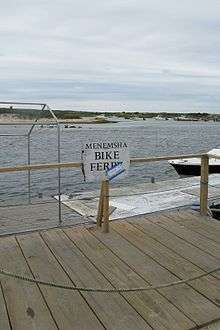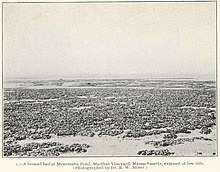Menemsha Pond
Menemsha Pond is a salt pond split between the towns of Aquinnah & Chilmark, Massachusetts.[1] At the mouth of the pond, the Menemsha Creek leads into the Menemsha Bight and the Vineyard Sound. Along Menemsha Creek sits the historic sea-side fishing village of Menemsha. Menemsha Pond connects to both Stonewall Pond via Nashaquitsa Pond and to Squibnocket Pond via the Squibnocket Herring Run.
| Menemsha Pond | |
|---|---|
| Location | Chilmark, Massachusetts & Aquinnah, Massachusetts |
| Coordinates | 41.3375°N 70.7733°W |
| Type | Salt Pond |
| Basin countries | United States |
| Surface area | 665 acres (269 ha) |
Since 1902, Menemsha Pond is a federally recognized Harbor of Refuge.[2] This designation altered the development of both the harbor at Menemsha and the channel into Menemsha Pond. Before the federal designation and redesign of the inlet, the channel was dredged locally to maintain access.
History
Archeological exploration indicates that indigenous peoples of the Wampanoag tribe have inhabited the shores of Menemsha Pond for approximately 10,000 to 7,500 years.[3] Additionally, the tribe still maintains a presence on the pound with the tribal run hatchery, herring run, and with the tribal members who fish both recreationally and commercially.[4] In his 1969 book, Archaeology of Martha's Vineyard, William A Ritchie excavated and carbon-dated materials found in the shell middens and living sites around the Vineyard including around Menemsha and Sqiudnocket Pond.[5]
In 1748 the Menemsha Road was laid out from Menemsha Pond to the common (south) road.
In 1890, the Chief of Engineers of the US Army conducted a preliminary examination of Menemsha Bight
Menemsha Bight, Massachusetts, an outlet into Vineyard Sound, on the north shore of the island of Marthas Vineyard, with a view of preventing the closing of said inlet. The improvement desired at this locality is the formation of a harbor of refuge for light-draft vessels by the construction of jetties and shore protection, estimated to cost $25,000. While this locality is regarded by Major Livermore and Col. Abbot as worthy of improvement, it is the opinion of these officers that in view of the difficulty of maintaining the improvement and of its large cost the demands of commerce do not justify the work being undertaken at the present time. Menemsha Bight is in the collection district of Edgartown, which is a port of entry. The amount of revenue collected at Edgartown in the last fiscal year was $310.94.[6]
Although no work was done on the bight or creek at that time, this report would be a harbinger.
In 1938, all but one building in the town of Menemsha was destroyed during the hurricane of 1938. The strong surf surged through Menemsha and the small barrier beach that separated Menemsha pond and the ocean, washing away the collection of fishing shacks that populated the village. In the aftermath of the hurricane, the Army Corps of Engineers dredged the channel and built jetties on either side, hardening Menemsha's status as a port of refuge. The Menemsha channel would wander and change shape often, until the jetties were built. In fact, the Wampanoag word for the channel to Menemsha Pond is Wawitukq, meaning "the winding, twisting river".[7] The 1938 hurricane also greatly damaged the fishing villages of Lobsterville and Squibnocket, both of whom would never recover. The new dredging of Menemsha harbor, with its added depth and dock space, made it ideal for the newly innovated motor-powered fishing and leisure boats.
Menemsha Bike Ferry
The Menemsha Bike Ferry, also known as the Aquinnah-Menemsha ferry, travels the short distance between Aquinnah and Chilmark, taking bikes and pedestrians over the water where Menemsha Pond meets Menemsha Creek.[8]

.jpg)
Administration
The pond is dually administered by the towns of Aquinnah and Chilmark. Each town has their own harbormaster.[9]
| Aquinnah Harbormaster | Chilmark Habormaster |
| Chip Vanderhoop | Ryan Rossi |
Fishing & Aquaculture
Menemsha Pond supports commercial oyster farming. The towns also seed bay scallops, quahogs, and oysters in the pond. In addition, the Wampanoag Tribe of Gay Head runs a hatchery on the southwest side of the pond. In the past, the hatchery conducted flounder spawning programs. Currently, there are no spawning programs; however, the tribe monitors the adjacent herring run from the hatchery building.[10]

| Aquinnah Shellfish Constable | Chilmark Shellfish Constable |
| Buddy Vanderhoop | Isaiah Scheffer |
| Natural Resource Department of the Wampanoag Tribe of Gay Head |
|---|
| Bret Stearns, Director - - - - - - - - - - - 508-645-9265 ext. 141 |
References
- "PondSummary" (PDF). MV Commission.
- "OFFICIALS DETERMINE MENEMSHA POND ANCHORING RULES". NewEnglandBoating.com. New England Boating.
- Hufstader, Louisa. "Aquinnah Sites Reveal 10,000 Years of Wampanoag History". The Vineyard Gazette.
- Hull, Olivia. "For Islanders, Ties to Coastal Ponds Run Deep". vineyardgazette.com. MV Gazette.
- Ritchie, William A. (1969). Archaeology of Martha's Vineyard. NY.
- ANNUAL REPORT OF THE CHIEF OF ENGINEERS, UNITED STATES ARMY, TO THE SECRETARY OF WAR, FOR THE YEAR 1892. Washington: GOVERNMENT PRINTING OFFICE. 1892.
- "Lobsterville: A History through the Eyes of a Fly Rod (excerpt)". Flogging the Waters.
- "Aquinnah: Open for the season". The Martha's Vineyard Times. 2018-05-23. Retrieved 2019-11-24.
- Dowd, Brian (2019-03-06). "Chilmark picks new harbormaster". The Martha's Vineyard Times. Retrieved 2019-06-21.
- "WINTER FLOUNDER ENHANCEMENT PROJECT". Natural Resource Department. Wampanoag Tribe.